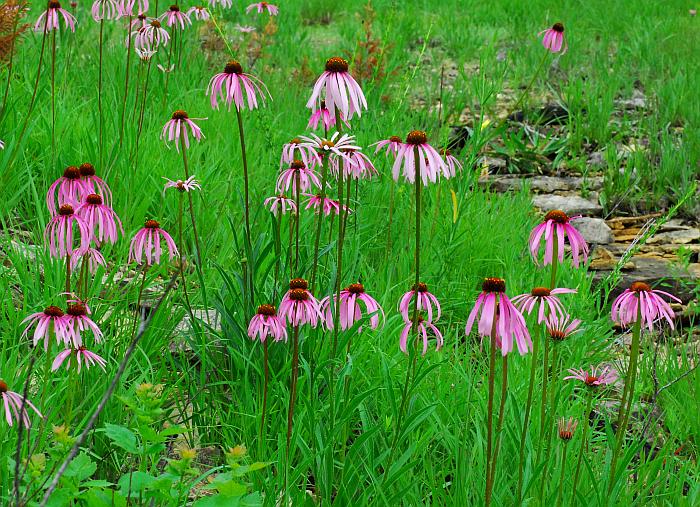Echinacea simulata McGregor
Glade Coneflower

Native
CC = 7
CW = 5
MOC = 24
© SRTurner
Echinacea simulata McGregorGlade Coneflower | |
 |
Native CC = 7 CW = 5 MOC = 24 |
© SRTurner |
|
Family - Asteraceae/Heliantheae Habit - Perennial forb with a usually elongated, vertical rootstock and often somewhat tuberous main roots, sometimes also with short, stout rhizomes. Stems - Erect, to 1.2 m, usually unbranched, moderately pubescent with stiff, spreading, minutely pustular-based hairs.
Leaves - Basal and alternate. Basal and lower stem leaves long-petiolate. Upper stem leaves shorter petiolate or sessile. Blades simple, entire, narrowly elliptic or lanceolate, to 25 cm, pubescent with stiff, spreading, minutely pustular-based hairs, roughened, usually with 3 main veins.
Inflorescence - Solitary terminal heads. Involucre - Bracts about 17-30 (the innermost bracts grading into the chaffy bracts), to 15 mm long, narrowly lanceolate, spreading to reflexed above the midpoint, green moderately pubescent, not glandular.
Heads - Heads radiate, with strongly convex receptacle. Florets subtended by chaffy bracts, these concave and wrapped around florets, sharply pointed, with spinelike tips exceeding disk corollas, with apical portion dark in color. Ray florets about 10-20, sterile, with ligules to 9 cm long, drooping, pink. Disk florets numerous, perfect, largely hidden by chaffy bracts, to 7 mm long, lobes pink or purple. Pollen yellow. Pappus a low crown similar in color to fruit body, persistent at fruiting.
Fruits - Wedge-shaped, slightly flattened and 4-angled in cross-section, 3.0-4.5 mm long, mostly smooth, the surface glabrous, tan to nearly white, sometimes slightly shiny Flowering - May - July. Habitat - Calcareous glades, bluff tops, savannas, forest openings, roadsides. Origin - Native to the U.S. Lookalikes - E. pallida, E. purpurea Other info. - This iconic species is mostly found in the southeastern quadrant of Missouri, extending into Arkansas, and with a few small populations in five more states to our south and east. The Echinacea genus is easily recognized by the strongly convex disks, which are prickly in texture from the hard, protruding chaffy bracts. E. simulata is identified by its long, drooping purple rays and yellow pollen. The pollen color serves to differentiate this plant from E. pallida, which looks very similar. In the absence of pollen the two can be hard to tell apart. Photographs taken in Missouri, 5-30-2009; 5-24-2010; and 6-2-2013 (SRTurner). |